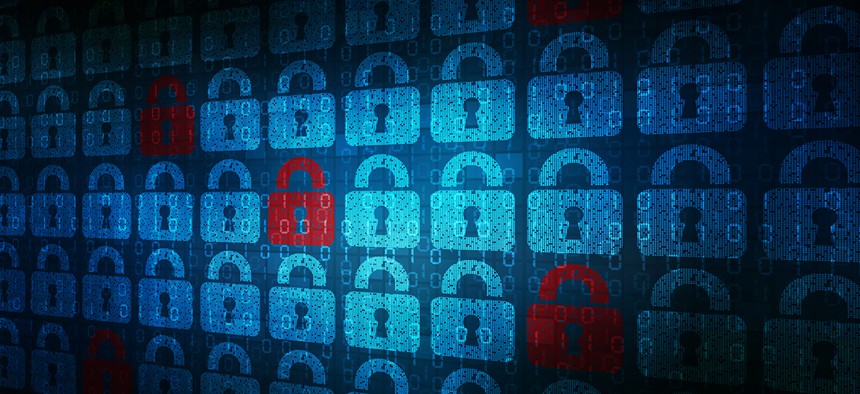5 Cybersecurity Truths to Know Now

deepadesigns/Shutterstock.com
Key points that will help agencies strengthen their defenses to keep data secure.
Peter Galvin is vice president of strategy and marketing at Thales e-Security.
National Cybersecurity Awareness Month draws attention to one of the most critical realities of our age: It can be dangerous to be online. Changing password frequently and avoid using public computers and Wi-Fi for financial transactions are just a couple of ways individuals can protect themselves.
When it comes to network security for government agencies, organizations need in-depth insight into the threats that lie in wait. Below are five key points about cybersecurity today that will help you strengthen your defenses to keep your data secure.
1. Common security failures have enabled cyberattacks to cause significant damage to businesses.
These failures include:
- Weak security hygiene. At the heart of many of the largest breaches are phishing attacks that capture user login information or enable malware installation. Many attacks succeed because default passwords have not been changed, patches have not been installed, accounts have excess privileges or system configurations are left in wide open, insecure states
- Insufficient Data Protection. The ultimate goal of most malicious actors is to obtain sensitive user information or critical data. Encrypting stored data is one of the most effective ways of thwarting such attacks. Encrypting data at all stages, at rest, in motion and in use is the best way to prevent critical data from being compromised. But it must be done -- securely, efficiently and effectively.
2. Attack vectors continue to shift.
Cyber criminals are increasingly better able to avoid detection, more selective about whom they target for attack and better at using counterfeit encryption keys and certificates. They create attacks that will go unnoticed by signature-based malware and intrusion-detection systems and use a variety of communication paths and techniques to avoid detection by DLP technology.
Attackers also zero in on specific data at specific organizations in specific fields. Increasingly, they zero in on people who have access to sensitive data: top-level directors and IT administrators. And, as mentioned above, they are upping their use of counterfeit encryption keys and certificates. A real-life example is Google’s discovery in 2014 that the National Informatics Centre of the Indian government had been issuing counterfeit keys being used in counterfeit websites. This discovery caused the NIC to cease its certificate issuing operations.
3. Private key extraction is a real threat.
Public-key algorithms are used for key exchange and transport encryption in a number of critical Internet protocols in use in high-value applications. The most common example is Secure Sockets Layer, which is the most widely used transport encryption on the Web. For the last eight years, though, attackers have been able to inspect server-side RAM and extract private keys by using randomization detection techniques. This attack has succeeded against a number of protocols:
- PKI certificate authorities
- Secure DNS servers
- VPN servers
- SSL servers
- SSH servers
To stop these attacks, the use of secure execution space for encryption is required.
If a trusted execution environment is available and has enough capacity, other sensitive applications and algorithms can be run in the highly secure TEE space. Examples include digital watermarking and digital currency (e.g. Bitcoin) processing.
4. Cyber criminals’ focus is now primarily data theft…
… where previously it was aimed at disrupting service or vandalism. This caused a corresponding shift to data protection. Common forms of data protection include transport encryption and persistent data encryption. For transport encryption, Secure Sockets Layer and Transport Layer Security are often used to safeguard sensitive data in motion over internal and external networks.
However, SSL/TLS do have vulnerabilities, leading to key and certification generation and validation occurring on vulnerable servers. By compromising software-only-based SSL server environments, attackers can compromise high volumes of user sessions with a single attack.
In terms of persistent data encryption, encrypting stored data can provide an exceptional level of protection against data breaches. However, if a server operating system is compromised, or if encryption and key management are not performed securely, data can be compromised.
5. High-security environments need trusted storage...
... and TEEs completely separate from IT operations and system administration. Diverse computing environments and performance issues – along with advanced threat vectors – have also driven the development and deployment of hardware security modules, trusted hardware appliances for running mission-critical security applications.
In the same way that firewalls are used to provide network security outside of the operational network, HSMs have evolved to provide trusted storage and execution for high-security applications. HSMs are purpose-built, highly secure appliances or stand-alone processors that implement trusted storage and encryption functions and can also include a TEE.
HSMs are typically used in encryption applications, for secure key generation, trusted encryption/decryption and secure certificate operations in certificate authorities used to generate and manage public-key certificates. For these reasons, many HSMs also include dedicated cryptographic processors that implement standards-compliant cryptographic algorithms and provide performance acceleration.
From Knowledge to Action
As technology evolves, so do attack methods. Common security mistakes like ineffective encryption and poor network hygiene have opened the door to successful attacks and emboldened attackers. They have gotten better at avoiding detection, targeting just the right people and counterfeiting or extracting private keys. Not even data encryption is foolproof.
For National Cybersecurity Awareness Month, we are looking ahead to see how organizations can best protect sensitive information assets well into the future. The current cybersecurity environment makes it clear that for high-value applications and processes hardware-based security is critical. To secure critical digital assets against today’s sophisticated onslaught of attacks, federal agencies must deploy a trusted system wholly removed from the operational network.
(Image via deepadesigns/Shutterstock.com)





